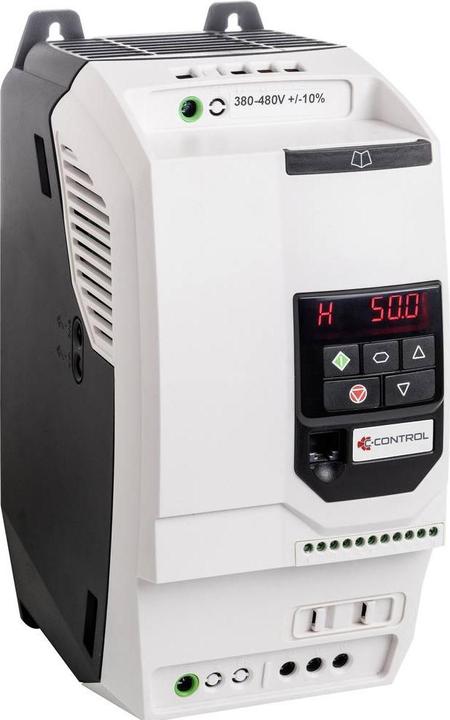
C-Control C Control frequency inverter CDI 075 3C3 0.75 kW 3-phase 400 V
Last updated 4 days ago. Automatically generated content.


Select options and limit the number of products
Power refers to the capacity of a frequency converter to handle electrical loads, directly affecting its ability to drive motors efficiently. Choosing the appropriate power level ensures optimal performance and energy efficiency for specific applications, from small appliances to industrial machinery.
Up to 4 kW
Typical price
890,– to 1600,–
Suitable for small motors and simple applications with lower power requirements.
Ideal for residential use or small workshops, providing energy-efficient operation for light tasks.
Bestseller

C-Control C Control frequency inverter CDI 075 3C3 0.75 kW 3-phase 400 V
5 - 18 kW
Typical price
1600,– to 2600,–
Designed for medium-sized motors, offering versatile application in various environments.
Perfect for commercial settings, ensuring reliable performance for moderate power needs and more complex machinery.
Bestseller
19 - 75 kW
Typical price
3900,– to 7800,–
Supports large industrial motors and heavy-duty applications with substantial power demands.
Recommended for large-scale operations, providing robust power for intensive tasks and enhanced productivity.
Bestseller
Electric current output determines the maximum current that a frequency converter can deliver, impacting the performance and suitability for various applications. Choosing the right current output ensures optimal compatibility with your equipment, preventing overload and ensuring efficient operation.
Up to 10 A
Typical price
490,– to 1600,–
Suitable for small-scale applications, delivering a lower current output.
Ideal for powering light-duty equipment, providing energy efficiency for smaller devices.
Bestseller

C-Control C Control frequency inverter CDI 075 3C3 0.75 kW 3-phase 400 V
11 - 39 A
Typical price
1200,– to 2600,–
Offers moderate current output, accommodating medium-sized equipment needs.
Recommended for standard industrial applications, balancing power and efficiency.
Bestseller
40 - 120 A
Typical price
3100,– to 6900,–
Provides high current output for demanding applications and heavy-duty equipment.
Ensures robust performance in large-scale operations, supporting intensive power requirements.
Bestseller
Mains voltage refers to the electrical power supply level that a frequency converter requires to operate. Choosing the appropriate voltage is crucial for ensuring optimal performance and compatibility with your existing electrical systems.
110 V
Typical price
890,– to 1200,–
Suitable for regions with standard 110 V supply, commonly found in North America.
Ideal for small to medium-sized applications, providing efficient power usage and flexibility.
Bestseller
230 V
Typical price
440,– to 2900,–
Standard in most European countries, offering compatibility with high-power equipment.
Recommended for industrial settings where higher voltage is necessary for effective operation.
Bestseller
380 V
Typical price
1300,– to 4900,–
Designed for heavy-duty industrial applications requiring robust power supply.
Provides enhanced performance for large-scale operations, supporting powerful machinery efficiently.
Bestseller
'Supports protocol' refers to the communication protocols that a frequency converter can interface with, determining compatibility with different control systems. Selecting the appropriate protocol is crucial for ensuring seamless integration with existing network infrastructure and optimizing system performance.
Modbus
Typical price
680,– to 3200,–
A widely used protocol that allows simple and efficient communication between devices in industrial settings.
Ideal for applications requiring straightforward and cost-effective connectivity, particularly in legacy systems.
Bestseller
DeviceNet
Typical price
1400,– to 5800,–
Designed for device-level communication, offering robust data exchange and connectivity.
Perfect for environments needing reliable device communication, enhancing operational efficiency and system control.
Bestseller
EtherNet/IP
Typical price
1200,– to 6200,–
Enables high-speed data transfer over Ethernet, supporting real-time communication and advanced networking.
Recommended for complex systems requiring fast and reliable communication, facilitating sophisticated automation solutions.
Bestseller
PROFINET IO
Typical price
1100,– to 3900,–
Offers real-time data exchange and integration with industrial Ethernet networks.
Best suited for high-demand applications where precision and speed are critical, providing enhanced system performance and scalability.
Bestseller
Output frequency refers to the range of frequencies a frequency converter can produce, impacting the operation speed and efficiency of connected equipment. Choosing the right output frequency ensures compatibility with your equipment and optimizes its performance for specific applications.
50 Hz
Typical price
750,– to 4100,–
Standard frequency used in many regions, ensuring compatibility with most equipment.
Ideal for general-purpose applications, providing consistent and reliable performance in standard settings.
Bestseller
50 - 60 Hz
Typical price
1000,– to 3400,–
Dual-frequency capability allows for flexible operation across different regions.
Perfect for global applications, offering adaptability for equipment used in various locations with differing frequency standards.
Bestseller

C-Control C Control frequency inverter CDI 075 3C3 0.75 kW 3-phase 400 V
47 / 63 Hz
Typical price
1200,– to 7800,–
Extended frequency range accommodates specific industrial applications requiring precise control.
Recommended for specialized equipment, providing enhanced versatility and efficiency in demanding environments.
Bestseller